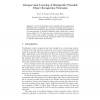Free Online Productivity Tools
i2Speak
i2Symbol
i2OCR
iTex2Img
iWeb2Print
iWeb2Shot
i2Type
iPdf2Split
iPdf2Merge
i2Bopomofo
i2Arabic
i2Style
i2Image
i2PDF
iLatex2Rtf
Sci2ools
BMCV
2000
Springer
2000
Springer
Unsupervised Learning of Biologically Plausible Object Recognition Strategies
Recent psychological and neurological evidence suggests that biological object recognition is a process of matching sensed images to stored iconic memories. This paper presents a partial implementation of
our interpretation of
Kosslyn's biological vision model, with a control system added to it. We then show how reinforcement learning can be used to control and optimize recognition in an unsupervised learning mode, where the result of image matching is used as the reward signal to optimize earlier stages of processing.
Biological Object Recognition | BMCV 2000 | Computer Vision | Kosslyn's Biological Vision | Unsupervised Learning Mode |
| Added | 02 Aug 2010 |
| Updated | 02 Aug 2010 |
| Type | Conference |
| Year | 2000 |
| Where | BMCV |
| Authors | Bruce A. Draper, Kyungim Baek |
Comments (0)

